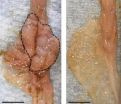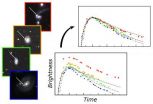Pediatric surgeons develop standards for children's surgical care in the United States
Journal of the American College of Surgeons report recommends three levels of surgical care based on personnel and other medical resources
2014-03-04
(Press-News.org) Chicago (March 3, 2014): The American College of Surgeons (ACS) has published new comprehensive guidelines that define the resources the nation's surgical facilities need to perform operations effectively and safely in infants and children. The standards—published in the March issue of the Journal of the American College of Surgeons—also have the approval of the American Pediatric Surgical Association and the Society of Pediatric Anesthesia. Representatives of these organizations as well as invited leaders in other pediatric medical specialties, known as the Task Force for Children's Surgical Care, developed the consensus recommendations over the past three years.
"The intent of these recommendations is to ensure that all infants and children in the United States receive care in a surgical environment matched to their individual medical, emotional, and social needs," said Keith T. Oldham, MD, FACS, task force chair and the surgeon in chief at Children's Hospital of Wisconsin, Milwaukee.
Millions of children undergo surgical procedures in this country every year according to Dr. Oldham. "There are still children today who receive surgical care in environments not matched to their needs," he said. "This scenario can affect how children fare after an operation."
Many studies show better results—from fewer complications to shorter hospital stays—when newborns and children undergo surgical procedures in environments that have expert resources for pediatric patients, compared with nonspecialized centers.
In its published report, the Task Force for Children's Surgical Care defined the proper surgical environment for children as one "that offers all of the facilities, equipment, and, most especially, access to the professional providers who have the appropriate background and training to provide optimal care."
To use terms familiar to the public, the task force assigned levels of resources,1 as the ACS has done for trauma centers for decades. The classification for children's surgical centers is as follows:
Level I (highest level): Possesses adequate resources to provide comprehensive surgical care and perform both complex and noncomplex surgical procedures in newborns and children of all ages, including those with the most severe health conditions and birth defects. Is staffed 24 hours a day, 7 days a week with properly credentialed pediatric specialists, including pediatric and subspecialty surgeons, pediatric anesthesiologists, pediatric diagnostic and interventional radiologists, and pediatric emergency physicians. Has a Level IV neonatal intensive care unit (NICU), the highest level of critical care for newborns.
Level II: Possesses adequate resources to provide advanced surgical care for children of all ages, including those who have accompanying ("comorbid") medical conditions. Operations would typically be performed by a single surgical specialty. Personnel include a certified pediatric surgeon, pediatric anesthesiologist, and pediatric radiologist; with other pediatric specialists readily available for consultation; and has an emergency physician and an intensive care unit that both have pediatric expertise. Has a Level III or higher NICU.
Level III: Possesses adequate resources to provide basic surgical care and perform common, low-risk surgical procedures in children older than 1 year who are otherwise healthy. Has a general surgeon, anesthesiologist, radiologist, and emergency physician, all of whom have pediatric expertise. Has a Level I NICU (well-newborn nursery) or higher.
Both Level II and III surgical centers must be able to stabilize and transfer critically ill children to a hospital with higher-level resources. All children's surgical centers must have at least one pediatric surgical nurse, a pediatric rapid response team of critical care professionals available at all hours, and an in-house physician with Pediatric Advanced Life Support certification or equivalent qualifications. Furthermore, these centers must be capable of performing pediatric resuscitation in all areas of the facility.
Additional guidelines for ambulatory, or outpatient, surgical centers include having preoperative and recovery areas dedicated to pediatric patients. Also according to the task force report, a pediatric anesthesiologist at an ambulatory surgical center should administer or supervise the administration of a general anesthetic or sedative to all infants below the age of 1 year.
Acknowledging that the standards are high, ACS Executive Director David B. Hoyt, MD, FACS, a member of the Task Force for Children's Surgical Care, added, "I think many hospitals will rise to these new standards by adding resources."
In designating the resources that children's surgical centers need, the Task Force for Children's Surgical Care reportedly relied on published scientific evidence and expert opinion. According to Dr. Oldham, supporting evidence included the success of the ACS' nationwide classification and verification system for trauma centers. By helping ensure that injured patients receive care at the appropriate level, the trauma system has saved many lives, he pointed out.
Plans are under way to develop criteria for evaluating existing facilities that perform children's surgical procedures, he reported. The ACS will oversee the site verification process, which Dr. Oldham expects to become available sometime this year.
Dr. Hoyt said the College has extensive experience in managing similar quality programs, including those for cancer, bariatric surgery, breast, and trauma centers. The verification process for children's surgical centers will distinguish their scope of resources, not quality of care, he stressed. However, he said the classification should help patients' families feel confident that they will get excellent routine surgical care at their community hospital.
Under the guidelines, some patients will need to go to a different hospital with more advanced resources. Although that may mean a small percentage of families must travel farther from home for their child's surgical care, Dr. Hoyt noted "the goal is to make sure the highest level of care is available for patients with the most complex needs."
"We have tried to put first the best interests of patients—sick kids with problems that need surgical care," he said.
INFORMATION:
The ACS and the Children's Hospital Association funded the work of the Task Force for Children's Surgical Care.
Citation: Journal of the American College of Surgeons, March 2014: Vol 218(3): 479-487.e4.
1The report in the Journal of the American College of Surgeons does not reflect this recent change in terms. The new designation of Level III refers to what the report called basic children's surgical centers, Level II corresponds to advanced centers, and Level I is the highest resource level, formerly designated comprehensive.
About the American College of Surgeons
The American College of Surgeons is a scientific and educational organization of surgeons that was founded in 1913 to raise the standards of surgical practice and improve the quality of care for surgical patients. The College is dedicated to the ethical and competent practice of surgery. Its achievements have significantly influenced the course of scientific surgery in America and have established it as an important advocate for all surgical patients. The College has more than 79,000 members and is the largest organization of surgeons in the world. For more information, visit http://www.facs.org.
ELSE PRESS RELEASES FROM THIS DATE:
HPV vaccine provides significant protection against cervical abnormalities
2014-03-04
The HPV vaccine offers significant protection against cervical abnormalities in young women, suggests a paper published on bmj.com today.
The human papillomavirus (HPV) can cause warts, with some strains causing cervical cancer.
Australia was the first country to implement a publicly funded national vaccination programme in April 2007 and a 'catch-up' programme that ran until December 2009.
Studies have shown that the two HPV vaccines used to vaccinate young women prevent cervical lesions associated with HPV types including vulval and vaginal lesions and genital ...
Report describes Central Hardwoods forest vulnerabilities, climate change impacts
2014-03-04
ST. PAUL, Minn., March 4, 2014 – Higher temperatures, more heavy precipitation, and drought. It's all expected in the Central Hardwoods Region of southern Indiana, southern Illinois, and the Missouri Ozarks, according to a new report by the U.S. Forest Service, and partners that assesses the vulnerability of the region's forest ecosystems and its ability to adapt to a changing climate.
More than 30 scientists and forest managers contributed to the report, which is part of the Central Hardwoods Climate Change Response Framework, a collaboration of federal, state, academic ...
Exploring sexual orientation and intimate partner violence
2014-03-04
HUNTSVILLE, TX (3/4/14) -- Two studies at Sam Houston State University examined issues of sexual orientation and intimate partner violence, including its impact on substance abuse and physical and mental health as well as the effects of child abuse on its victims.
"We wanted to see how characteristics of the victims might differ based on if they were heterosexual or non-heterosexual," said Maria Koeppel, a Ph.D. student at the College of Criminal Justice, who coauthored the studies with Dr. Leana Bouffard. "These studies show the need to have specialized programs designed ...
New probes from Scripps research quantify folded and misfolded protein levels in cells
2014-03-04
LA JOLLA, CA – March 4, 2014 – Scientists at The Scripps Research Institute (TSRI) have invented small-molecule folding probes that enable them to quantify functional, normally folded and disease-associated misfolded conformations (shapes) of a protein-of-interest in cells under different conditions.
Scientists have long needed better tools for making such measurements in cells, because protein misfolding is a major cause of damage to tissues. Disorders that feature excessive protein misfolding afflict millions of people worldwide and include Alzheimer's and Parkinson's ...
Gene transfer optimization
2014-03-04
Lentiviruses, which belong to the family of retroviruses, are used as vectors to exchange genetic material in cells and can be used to replace a defective gene as defined by gene therapy. Increasing the efficiency of such a treatment poses a major medical challenge: the virus should specifically track the target cells, but the number of virus used should be as low as possible.
A research team led by Dr. Ines Höfig and Dr. Natasa Anastasov from the Institute of Radiation Biology (ISB) at Helmholtz Zentrum München in cooperation with Sirion Biotech GmbH in Munich and the ...
Screening does not shift breast cancer to earlier stages
2014-03-04
Screening for breast cancer appeared to have a very limited effect on the occurrence of serious and aggressive cancer cases. On the other hand, it appeared to detect many more early cancer cases, cases which would otherwise never have developed - but which are treated due to screening.
This is the conclusion of a study from Aarhus University, Denmark, that has just been published in the European Journal of Public Health based on data from all women over the age of 20 in Norway (approx. 1.8 million in 2010).
Looks at the various stages of cancer
The new element is that ...
Pulling polymers leads to new insights into their mechanical behavior
2014-03-04
In collaboration with colleagues from Berlin and Madrid, researchers at the Department of Physics at the University of Basel have pulled up isolated molecular chains from a gold surface, using the tip of an atomic force microscope (AFM). The observed signal provides insight into the detachment force and binding energy of molecules. The results have been published in the renowned scientific journal PNAS.
Atomic force microscopy is a method normally used for imaging matter with very high resolution. The sharp tip of the microscope is used to scan the surface line by line. ...
Yoga regulates stress hormones and improves quality of life for women with breast cancer undergoing radiation therapy
2014-03-04
HOUSTON — For women with breast cancer undergoing radiation therapy, yoga offers unique benefits beyond fighting fatigue, according to research from The University of Texas MD Anderson Cancer Center.
The preliminary findings were first reported in 2011 by Lorenzo Cohen, Ph.D., professor and director of the Integrative Medicine Program at MD Anderson, and are now published in the Journal of Clinical Oncology. This research is part of an ongoing effort to scientifically validate mind-body interventions in cancer patients and was conducted in collaboration with India's ...
Eliminating bacteria, changing lifestyle could lower risk in people genetically susceptible to colorectal cancer
2014-03-04
New York, NY— Bacteria in the gut are essential for the development of intestinal tumors in mice, according to research led by investigators from the Icahn School of Medicine at Mount Sinai. Removing the bacteria may play a critical role in reducing cancer risk, the researchers write, in the March issue of the Journal of Experimental Medicine.
Sergio A. Lira, MD, PhD, Director of the Immunology Institute, and Professor of Immunology and Medicine, and his laboratory at the Icahn School of Medicine at Mount Sinai, used a transgenic mouse model to test the hypothesis that ...
Standard-candle supernovae are still standard, but why?
2014-03-04
Sixteen years ago two teams of supernova hunters, one led by Saul Perlmutter of the U.S. Department of Energy's Lawrence Berkeley National Laboratory (Berkeley Lab), the other by Brian Schmidt of the Australian National University, declared that the expansion of the universe is accelerating – a Nobel Prize-winning discovery tantamount to the discovery of dark energy. Both teams measured how fast the universe was expanding at different times in its history by comparing the brightnesses and redshifts of Type Ia supernovae, the best cosmological "standard candles."
These ...
LAST 30 PRESS RELEASES:
Tracing the quick synthesis of an industrially important catalyst
New software sheds light on cancer’s hidden genetic networks
UT Health San Antonio awarded $3 million in CPRIT grants to bolster cancer research and prevention efforts in South Texas
Third symposium spotlights global challenge of new contaminants in China’s fight against pollution
From straw to soil harmony: International team reveals how biochar supercharges carbon-smart farming
Myeloma: How AI is redrawing the map of cancer care
Manhattan E. Charurat, Ph.D., MHS invested as the Homer and Martha Gudelsky Distinguished Professor in Medicine at the University of Maryland School of Medicine
Insilico Medicine’s Pharma.AI Q4 Winter Launch Recap: Revolutionizing drug discovery with cutting-edge AI innovations, accelerating the path to pharmaceutical superintelligence
Nanoplastics have diet-dependent impacts on digestive system health
Brain neuron death occurs throughout life and increases with age, a natural human protein drug may halt neuron death in Alzheimer’s disease
SPIE and CLP announce the recipients of the 2025 Advanced Photonics Young Innovator Award
Lessons from the Caldor Fire’s Christmas Valley ‘Miracle’
Ant societies rose by trading individual protection for collective power
Research reveals how ancient viral DNA shapes early embryonic development
A molecular gatekeeper that controls protein synthesis
New ‘cloaking device’ concept to shield sensitive tech from magnetic fields
Researchers show impact of mountain building and climate change on alpine biodiversity
Study models the transition from Neanderthals to modern humans in Europe
University of Phoenix College of Doctoral Studies releases white paper on AI-driven skilling to reduce burnout and restore worker autonomy
AIs fail at the game of visual “telephone”
The levers for a sustainable food system
Potential changes in US homelessness by ending federal support for housing first programs
Vulnerability of large language models to prompt injection when providing medical advice
Researchers develop new system for high-energy-density, long-life, multi-electron transfer bromine-based flow batteries
Ending federal support for housing first programs could increase U.S. homelessness by 5% in one year, new JAMA study finds
New research uncovers molecular ‘safety switch’ shielding cancers from immune attack
Bacteria resisting viral infection can still sink carbon to ocean floor
Younger biological age may increase depression risk in older women during COVID-19
Bharat Innovates 2026 National Basecamp Showcases India’s Most Promising Deep-Tech Ventures
Here’s what determines whether your income level rises or falls
[Press-News.org] Pediatric surgeons develop standards for children's surgical care in the United StatesJournal of the American College of Surgeons report recommends three levels of surgical care based on personnel and other medical resources




